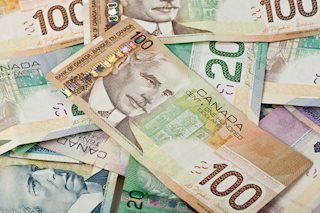USD/CAD stands tall near three-month peak, above 1.3800 as traders look to US Q2 GDP
|
- A combination of factors pushes USD/CAD higher for the seventh straight day on Thursday.
- The recent fall in Oil prices, along with the BoC’s dovish outlook, undermines the Loonie.
- Bulls seem unaffected by a softer USD, though seem reluctant ahead of the US macro data.
The USD/CAD pair builds on its recent upward trajectory witnessed over the past two weeks or so and continues to gain traction for the seventh successive day on Thursday. This also marks the tenth day of a positive move in the previous eleven and lifts spot prices to the highest level since April 17, around the 1.3820 region during the Asian session.
Crude Oil prices languish near a one-and-half-month low touched earlier this week amid concerns about a slowing demand from China – the world's largest importer. This, along with the Bank of Canada's (BoC) dovish outlook, continues to undermine the commodity-linked Loonie and acts as a tailwind for the USD/CAD pair. In fact, the Canadian central bank lowered its key policy rate by 25 basis points for the second straight month on Wednesday and said more cuts were likely if inflation continued to cool in line with forecasts.
Adding to this, the BoC trimmed its 2024 growth forecast to a lacklustre 1.2% from the 1.5% predicted in April and reiterated that inflation should return sustainably to the 2% target in the second half of 2025. The markets were quick to react and are now pricing in over a 52% chance that the central bank will cut interest rates again at its next monetary policy meeting in September. This, to a larger extent, overshadows a modest US Dollar (USD) downtick and supports prospects for a further appreciating move for the USD/CAD pair.
That said, expectations that the Federal Reserve (Fed) will begin its rate-cutting cycle in September might hold back traders from placing fresh bets ahead of the crucial US macro data. The Advance US Q2 GDP print is due for release later this Thursday and will be followed by the Personal Consumption Expenditures (PCE) Price Index on Friday. This will play a key role in influencing the Fed's policy path, which, in turn, will drive the USD demand. Apart from this, Oil price dynamics should provide a fresh directional impetus to the USD/CAD pair.
Canadian Dollar FAQs
The key factors driving the Canadian Dollar (CAD) are the level of interest rates set by the Bank of Canada (BoC), the price of Oil, Canada’s largest export, the health of its economy, inflation and the Trade Balance, which is the difference between the value of Canada’s exports versus its imports. Other factors include market sentiment – whether investors are taking on more risky assets (risk-on) or seeking safe-havens (risk-off) – with risk-on being CAD-positive. As its largest trading partner, the health of the US economy is also a key factor influencing the Canadian Dollar.
The Bank of Canada (BoC) has a significant influence on the Canadian Dollar by setting the level of interest rates that banks can lend to one another. This influences the level of interest rates for everyone. The main goal of the BoC is to maintain inflation at 1-3% by adjusting interest rates up or down. Relatively higher interest rates tend to be positive for the CAD. The Bank of Canada can also use quantitative easing and tightening to influence credit conditions, with the former CAD-negative and the latter CAD-positive.
The price of Oil is a key factor impacting the value of the Canadian Dollar. Petroleum is Canada’s biggest export, so Oil price tends to have an immediate impact on the CAD value. Generally, if Oil price rises CAD also goes up, as aggregate demand for the currency increases. The opposite is the case if the price of Oil falls. Higher Oil prices also tend to result in a greater likelihood of a positive Trade Balance, which is also supportive of the CAD.
While inflation had always traditionally been thought of as a negative factor for a currency since it lowers the value of money, the opposite has actually been the case in modern times with the relaxation of cross-border capital controls. Higher inflation tends to lead central banks to put up interest rates which attracts more capital inflows from global investors seeking a lucrative place to keep their money. This increases demand for the local currency, which in Canada’s case is the Canadian Dollar.
Macroeconomic data releases gauge the health of the economy and can have an impact on the Canadian Dollar. Indicators such as GDP, Manufacturing and Services PMIs, employment, and consumer sentiment surveys can all influence the direction of the CAD. A strong economy is good for the Canadian Dollar. Not only does it attract more foreign investment but it may encourage the Bank of Canada to put up interest rates, leading to a stronger currency. If economic data is weak, however, the CAD is likely to fall.
Information on these pages contains forward-looking statements that involve risks and uncertainties. Markets and instruments profiled on this page are for informational purposes only and should not in any way come across as a recommendation to buy or sell in these assets. You should do your own thorough research before making any investment decisions. FXStreet does not in any way guarantee that this information is free from mistakes, errors, or material misstatements. It also does not guarantee that this information is of a timely nature. Investing in Open Markets involves a great deal of risk, including the loss of all or a portion of your investment, as well as emotional distress. All risks, losses and costs associated with investing, including total loss of principal, are your responsibility. The views and opinions expressed in this article are those of the authors and do not necessarily reflect the official policy or position of FXStreet nor its advertisers.